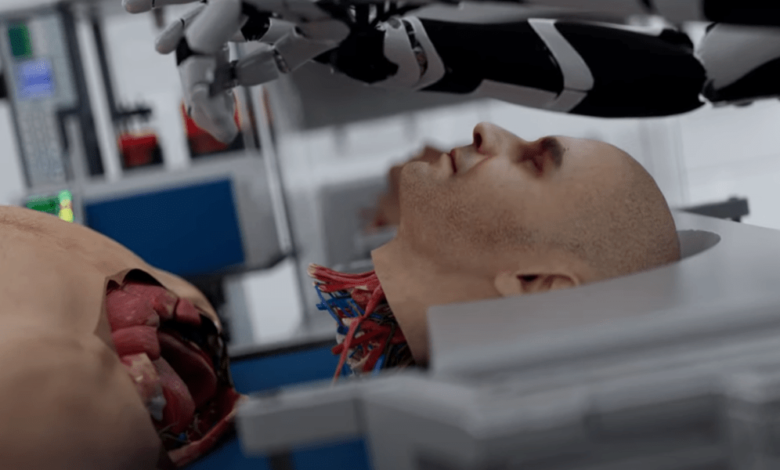The Download: head transplants, and filtering sounds with AI

Plus: Google’s AI search is going from bad to worse
This is today’s edition of The Download, our weekday newsletter that provides a daily dose of what’s going on in the world of technology.
That viral video showing a head transplant is a fake. But it might be real someday.
An animated video posted this week has a voice-over that sounds like a late-night TV ad, but the pitch is straight out of the far future. The arms of an octopus-like robotic surgeon swirl, swiftly removing the head of a dying man and placing it onto a young, healthy body.
This is BrainBridge, the animated video claims—“the world’s first revolutionary concept for a head transplant machine, which uses state-of-the-art robotics and artificial intelligence to conduct complete head and face transplantation.”
BrainBridge is not a real company—it’s not incorporated anywhere. Yet it’s not merely a provocative work of art. This video is better understood as the first public billboard for a hugely controversial scheme to defeat death that’s recently been gaining attention among some life-extension proponents and entrepreneurs. Read the full story.
—Antonio Regalado
Noise-canceling headphones use AI to let a single voice through
Modern life is noisy. If you don’t like it, noise-canceling headphones can reduce the sounds in your environment. But they muffle sounds indiscriminately, so you can easily end up missing something you actually want to hear.
A new prototype AI system for such headphones aims to solve this. Called Target Speech Hearing, the system gives users the ability to select a person whose voice will remain audible even when all other sounds are canceled out.
Although the technology is currently a proof of concept, its creators say they are in talks to embed it in popular brands of noise-canceling earbuds and are also working to make it available for hearing aids. Read the full story.
—Rhiannon Williams
Splashy breakthroughs are exciting, but people with spinal cord injuries need more
—Cassandra Willyard
This week, I wrote about an external stimulator that delivers electrical pulses to the spine to help improve hand and arm function in people who are paralyzed. This isn’t a cure. In many cases the gains were relatively modest.
The study didn’t garner as much media attention as previous, much smaller studies that focused on helping people with paralysis walk. Tech that allows people to type slightly faster or put their hair in a ponytail unaided just doesn’t have the same allure.
For the people who have spinal cord injuries, however, incremental gains can have a huge impact on quality of life. So who does this tech really serve? Read the full story.
This story is from The Checkup, our weekly health and biotech newsletter. Sign up to receive it in your inbox every Thursday.
The must-reads
I’ve combed the internet to find you today’s most fun/important/scary/fascinating stories about technology.
1 Google’s AI search is advising people to put glue on pizza
These tools clearly aren’t ready to provide billions of users with accurate answers. (The Verge)
+ That $60 million Google paid Reddit for its data sure looks questionable. (404 Media)
+ But who’s legally responsible here? (Vox)
+ Why you shouldn’t trust AI search engines. (MIT Technology Review)
2 Russia is increasingly interfering with Ukraine’s Starlink service
It’s disrupting Ukraine’s ability to collect intelligence and conduct drone attacks. (NYT $)
3 Taiwan is prepared to shut down its chipmaking machines if China invades
China is currently circling the island on military exercises. (Bloomberg $)
+ Meanwhile, China’s PC makers are on the up. (FT $)
+ What’s next in chips. (MIT Technology Review)
4 X is planning on hiding users’ likes
Elon Musk wants to encourage users to like ‘edgy’ content without fear. (Insider $)
5 The scammer who cloned Joe Biden’s voice could be fined $6 million
Regulators want to make it clear that political AI manipulation will not be tolerated. (TechCrunch)
+ He’s due to appear in court next month. (Reuters)
+ Meta says AI-generated election content is not happening at a “systemic level.” (MIT Technology Review)
6 NSO Group’s former CEO is staging a comeback
Shalev Huloi resigned after the US blacklisted the company. (The Intercept)
7 Rivers in Alaska are running orange
It’s highly likely that climate change is to blame. (WP $)
+ It’s looking unlikely that we’re going to limit global warming to 1.5°C. (New Scientist $)
8 We’re learning more about one of the world’s rarest elements
Promethium is extremely radioactive, and extremely unstable. (New Scientist $)
9 Children can’t really become music lovers without a phone
Without cassette players or CDs, streaming seems the only option.(The Guardian)
10 AI art will always look cheap 🖼️
It’s no substitute for the real deal. (Vox)
+ This artist is dominating AI-generated art. And he’s not happy about it. (MIT Technology Review)
Quote of the day
“Naming space as a warfighting domain was kind of forbidden, but that’s changed.”
—Air Force General Charles “CQ” Brown explains how the US is preparing to fight adversaries in space, Ars Technica reports.
The big story
How Facebook got addicted to spreading misinformation
March 2021
When the Cambridge Analytica scandal broke in March 2018, it would kick off Facebook’s largest publicity crisis to date. It compounded fears that the algorithms that determine what people see were amplifying fake news and hate speech, and prompted the company to start a team with a directive that was a little vague: to examine the societal impact of the company’s algorithms.
Joaquin Quiñonero Candela was a natural pick to head it up. In his six years at Facebook, he’d created some of the first algorithms for targeting users with content precisely tailored to their interests, and then he’d diffused those algorithms across the company. Now his mandate would be to make them less harmful. However, his hands were tied, and the drive to make money came first. Read the full story.
—Karen Hao



